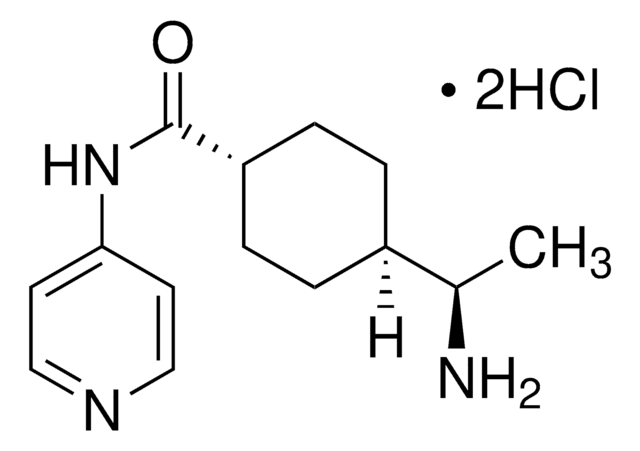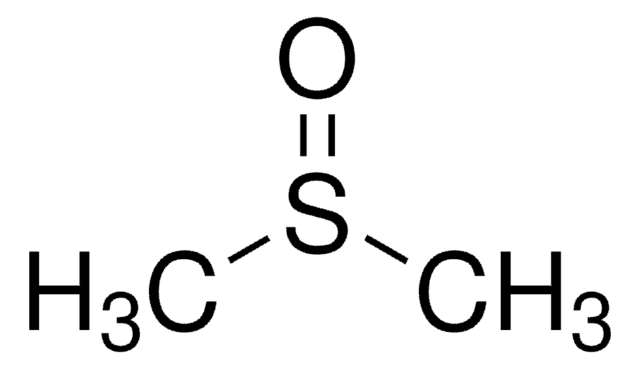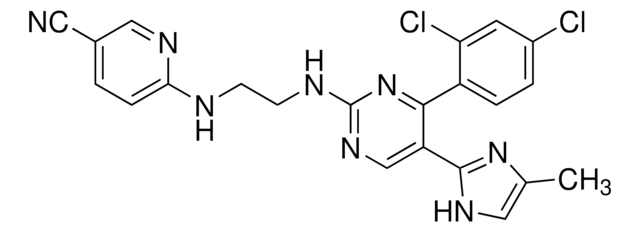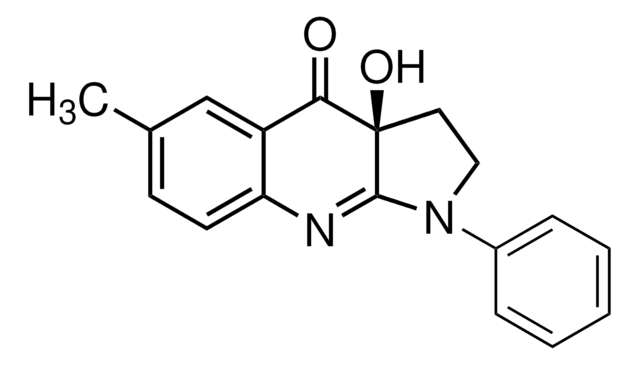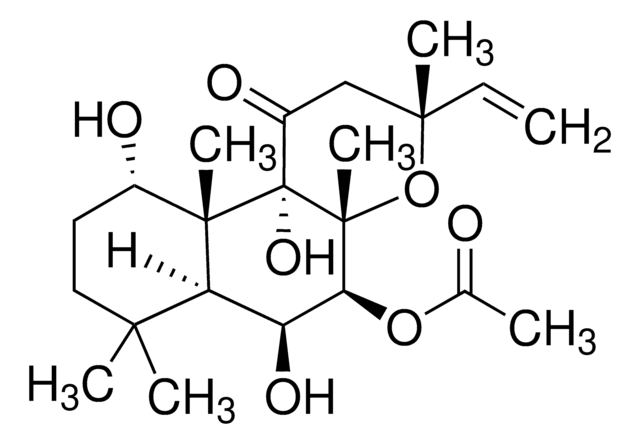CSA001
Rho-associated Kinase (ROCK) Activity Assay
This Rho-associated Protein Kinase (ROCK) Activity Assay Kit is an enzyme immunoassay for detection of the active ROCK & DMPK family kinases.
Sign Into View Organizational & Contract Pricing
All Photos(7)
About This Item
UNSPSC Code:
12161503
eCl@ss:
32161000
NACRES:
NA.32
Recommended Products
species reactivity (predicted by homology)
all
manufacturer/tradename
Chemicon®
technique(s)
activity assay: suitable
detection method
colorimetric
shipped in
ambient
General description
Introduction:
Small GTPase proteins of the Rho family are pivotal regulators of several aspects of cell behavior, such as cell motility, cell proliferation and apoptosis. They have a central role in many motile responses that involve the actin cytoskeleton and/or microtubule network, from neurite extension to phagocytosis and cancer-cell invasion. In addition, they contribute to changes in gene expression that lead to cell-cycle progression or differentiated cell responses. Rho is activated by extracellular signals such as lysophosphatidic acid (LPA). The actions of Rho are mediated by downstream Rho effectors. One of these effectors is Rho-associated protein kinase (ROCK). Two ROCK isoforms have been identified: ROCK-I (also known as ROKβ) and ROCK-II (also known as Rho Kinase and ROKα). ROCK mediates Rho signaling and reorganizes the actin cytoskeleton through phosphorylation of several substrates that contribute to the assembly of actin filaments and contractility.
ROCK inactivates myosin phosphatase through the specific phosphorylation of myosin phosphatase target subunit 1 (MYPT1) at threonine residue 696, which results in an increase in the phosphorylated form of the 20 kDa myosin light chain (MLC20). This threonine residue may also be phosphorylated by myotonic dystrophy protein kinase (DMPK) family kinases.
Test Principle:
Millipore’s Rho-associated Protein Kinase (ROCK) Activity Assay Kit is an enzyme immunoassay for detection of the active ROCK and DMPK family kinases. Plates are pre-coated with recombinant MYPT1, which contains a Thr696 residue that may be phosphorylated upon addition of ROCK-I, ROCK-II, or DMPK. A detection antibody that specifically detects only MYPT1 phosphorylated at Thr696 is then applied. Subsequently, an HRP-conjugated secondary detection antibody is added. The amount of phoshorylated substrate is measured by addition of the chromogenic substrate tetra-methylbenzidine (TMB), which bound HRP converts from a colorless solution to a blue solution (or yellow after the addition of stop solution). The absorbance signal at 450 nm reflects the relative amount of ROCK activity in the sample.
The ROCK assay kit is designed to determine the presence and relative amount of purified ROCK activity as well as for screening inhibitors or activators of ROCK or DMPK family kinases.
Small GTPase proteins of the Rho family are pivotal regulators of several aspects of cell behavior, such as cell motility, cell proliferation and apoptosis. They have a central role in many motile responses that involve the actin cytoskeleton and/or microtubule network, from neurite extension to phagocytosis and cancer-cell invasion. In addition, they contribute to changes in gene expression that lead to cell-cycle progression or differentiated cell responses. Rho is activated by extracellular signals such as lysophosphatidic acid (LPA). The actions of Rho are mediated by downstream Rho effectors. One of these effectors is Rho-associated protein kinase (ROCK). Two ROCK isoforms have been identified: ROCK-I (also known as ROKβ) and ROCK-II (also known as Rho Kinase and ROKα). ROCK mediates Rho signaling and reorganizes the actin cytoskeleton through phosphorylation of several substrates that contribute to the assembly of actin filaments and contractility.
ROCK inactivates myosin phosphatase through the specific phosphorylation of myosin phosphatase target subunit 1 (MYPT1) at threonine residue 696, which results in an increase in the phosphorylated form of the 20 kDa myosin light chain (MLC20). This threonine residue may also be phosphorylated by myotonic dystrophy protein kinase (DMPK) family kinases.
Test Principle:
Millipore’s Rho-associated Protein Kinase (ROCK) Activity Assay Kit is an enzyme immunoassay for detection of the active ROCK and DMPK family kinases. Plates are pre-coated with recombinant MYPT1, which contains a Thr696 residue that may be phosphorylated upon addition of ROCK-I, ROCK-II, or DMPK. A detection antibody that specifically detects only MYPT1 phosphorylated at Thr696 is then applied. Subsequently, an HRP-conjugated secondary detection antibody is added. The amount of phoshorylated substrate is measured by addition of the chromogenic substrate tetra-methylbenzidine (TMB), which bound HRP converts from a colorless solution to a blue solution (or yellow after the addition of stop solution). The absorbance signal at 450 nm reflects the relative amount of ROCK activity in the sample.
The ROCK assay kit is designed to determine the presence and relative amount of purified ROCK activity as well as for screening inhibitors or activators of ROCK or DMPK family kinases.
Application
Millipore’s Rho-associated Protein Kinase (ROCK) Activity Assay Kit is an enzyme immunoassay for detection of the active ROCK and DMPK family kinases. Plates are pre-coated with recombinant MYPT1, which contains a Thr696 residue that may be phosphorylated upon addition of ROCK-I, ROCK-II, or DMPK. A detection antibody that specifically detects only MYPT1 phosphorylated at Thr696 is then applied. Subsequently, an HRP-conjugated secondary detection antibody is added. The amount of phoshorylated substrate is measured by addition of the chromogenic substrate tetra-methylbenzidine (TMB), which bound HRP converts from a colorless solution to a blue solution (or yellow after the addition of stop solution). The absorbance signal at 450 nm reflects the relative amount of ROCK activity in the sample.
The ROCK assay kit is designed to determine the presence and relative amount of purified ROCK activity as well as for screening inhibitors or activators of ROCK or DMPK family kinases. It can also be used to assess the potency of pharmacological agents on ROCK or DMPK family kinases.
The ROCK assay kit is designed to determine the presence and relative amount of purified ROCK activity as well as for screening inhibitors or activators of ROCK or DMPK family kinases. It can also be used to assess the potency of pharmacological agents on ROCK or DMPK family kinases.
Components
MYPT1 Pre-coated 96-well Multistrip Plate: One 96-well multistrip plate pre-coated with MYPT1
Anti-phospho-MYPT1(Thr696) Antibody: One vial containing 10 µg of anti-phospho-MYPT1(Thr696) antibody
TMB/E Substrate: One bottle containing 12 mL
Stop Solution: One bottle containing 12 mL
TBS, 20X: One bottle containing 50 mL 20X TBS
20% Tween® 20 (v/v): One bottle containing 3 mL
Plate Sealers: Two plate covers
Assay Dilution Buffer I: One vial containing 1 mL
ATP (10mM): One vial containing 50 µL
MgCl2 (1M): One vial containing 100 µL
30% BSA: One vial containing 1 mL
Goat Anti-Rabbit IgG HRP Secondary Antibody: One vial containing 30 µL
ROCK Inhibitor Y-27632: One vial containing 150 µL
Active Rho-associated Kinase II (ROCK-II): One vial containing 10 µg
Anti-phospho-MYPT1(Thr696) Antibody: One vial containing 10 µg of anti-phospho-MYPT1(Thr696) antibody
TMB/E Substrate: One bottle containing 12 mL
Stop Solution: One bottle containing 12 mL
TBS, 20X: One bottle containing 50 mL 20X TBS
20% Tween® 20 (v/v): One bottle containing 3 mL
Plate Sealers: Two plate covers
Assay Dilution Buffer I: One vial containing 1 mL
ATP (10mM): One vial containing 50 µL
MgCl2 (1M): One vial containing 100 µL
30% BSA: One vial containing 1 mL
Goat Anti-Rabbit IgG HRP Secondary Antibody: One vial containing 30 µL
ROCK Inhibitor Y-27632: One vial containing 150 µL
Active Rho-associated Kinase II (ROCK-II): One vial containing 10 µg
Storage and Stability
Store kit materials at specified temperatures on the label and manual; use within 4 months from date of receipt.
Legal Information
CHEMICON is a registered trademark of Merck KGaA, Darmstadt, Germany
TWEEN is a registered trademark of Croda International PLC
Signal Word
Warning
Hazard Statements
Precautionary Statements
Hazard Classifications
Met. Corr. 1 - Skin Sens. 1
Storage Class Code
8A - Combustible corrosive hazardous materials
Regulatory Information
新产品
Certificates of Analysis (COA)
Search for Certificates of Analysis (COA) by entering the products Lot/Batch Number. Lot and Batch Numbers can be found on a product’s label following the words ‘Lot’ or ‘Batch’.
Already Own This Product?
Find documentation for the products that you have recently purchased in the Document Library.
Karolien Hollanders et al.
Current eye research, 42(2), 260-272 (2016-07-12)
Diabetic retinopathy (DR) is characterized by an early stage of inflammation and vessel leakage, and an advanced vasoproliferative stage. Also, neurodegeneration might play an important role in disease pathogenesis. The aim of this study was to investigate the effect of
Joseph Jude et al.
American journal of respiratory cell and molecular biology, 55(4), 542-553 (2016-05-06)
Formaldehyde, a common indoor air pollutant, exacerbates asthma and synergizes with allergen to induce airway hyperresponsiveness (AHR) in animal models. The mechanisms mediating formaldehyde-induced AHR remain poorly understood. We posit that formaldehyde modulates agonist-induced contractile response of human airway smooth
Taslim A Al-Hilal et al.
Journal of controlled release : official journal of the Controlled Release Society, 334, 237-247 (2021-04-30)
ROCK, one of the downstream regulators of Rho, controls actomyosin cytoskeleton organization, stress fiber formation, smooth muscle contraction, and cell migration. ROCK plays an important role in the pathologies of cerebral and coronary vasospasm, hypertension, cancer, and arteriosclerosis. Pharmacological-induced systemic
Paolo Armando Gagliardi et al.
The Journal of cell biology, 206(3), 415-434 (2014-08-06)
Directional cell migration is of paramount importance in both physiological and pathological processes, such as development, wound healing, immune response, and cancer invasion. Here, we report that 3-phosphoinositide-dependent kinase 1 (PDK1) regulates epithelial directional migration and invasion by binding and
Aurelie Nguyen Dinh Cat et al.
Scientific reports, 8(1), 2952-2952 (2018-02-15)
Activation of aldosterone/mineralocorticoid receptors (MR) has been implicated in vascular dysfunction of diabetes. Underlying mechanisms are elusive. Therefore, we investigated the role of Rho kinase (ROCK) in aldosterone/MR signaling and vascular dysfunction in a model of diabetes. Diabetic obese mice
Our team of scientists has experience in all areas of research including Life Science, Material Science, Chemical Synthesis, Chromatography, Analytical and many others.
Contact Technical Service